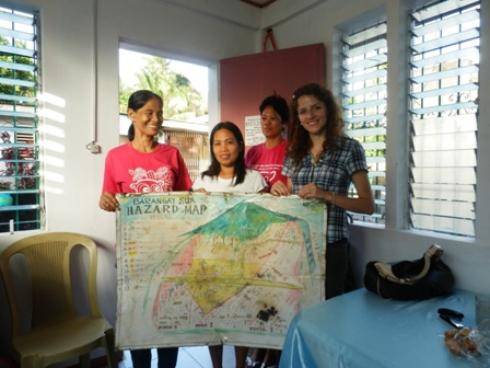Whilst a number of disaster risk reduction policies emphasise the need for a multi-hazard approach, little guidance exists for non-scientific practitioners (e.g., non-governmental organisations) on how to include multi-hazards in their assessments of risk. This is in part due to the assumptions behind the concept of ‘multi-hazard’ and the reality that much research branded as multi-hazard simply looks at more than one hazard in a given place, rather than the interaction or compounding effects of these hazards. It is necessary to anticipate these complex interrelations in order to inform strategies for building community resilience.
Through a partnership with CAFOD, a project began in 2009 on multi-hazard assessments for building resilient communities in the Philippines. The aim of the research was to develop methods for multi-(natural) hazard assessment, which can be applied by the NGO sector. The researcher, Melanie Duncan, has drawn upon the practical experience of hazard assessment conducted by international NGOs based in the UK and international and local NGOs working in the Philippines. The research highlights current shortfalls in how humanitarian and development agencies evaluate the threat from multi-hazards, whilst also emphasising the practical limitations on the theoretical ambitions of multi-hazard analysis, in terms of the actuality of implementation.
- Multi-Hazard Research: Philippines
- Melanie Duncan meeting with community representatives on the slopes of Mt Mayon, courtesy of local NGO TABI (October, 2012)

The Philippines was selected as a case study for the multi-hazard research owing to the fact that it represents a truly multi-hazardous environment. The island archipelago is home to 22 active volcanoes (47 Holocene Volcanoes, Aspinall et al., 2011) as well as being the meeting point of several major subducting plate margins and bisected by the strike-slip Philippines fault zone. Given it's geographical location, the islands are exposed to tropical cylones and, thus its vulnerable population are at risk from often a combination of typhoon, flooding, volcanic and earthquake risk, not to mention the secondary hazards these often trigger, including landslides and tsunamis, and the compounding effects of environmental degradation, drought and conflict.
- Publications
Kappes, M. S., Keiler, M., von Elverfeldt, K., and Glade, T. (2012) Challenges of analyzing multi-hazard risk: a review. Nat. Hazards, pp.1-34.
 Close
Close


